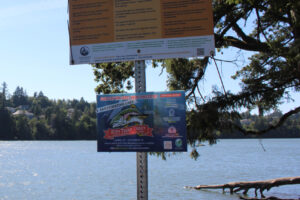Clark County Public Health has issued a warning advisory at Lacamas and Round lakes in Camas due to elevated levels of cyanotoxins from harmful algae.
The County issued the Lacamas Lake warning Wednesday, Aug. 28. Results from water samples taken from Round Lake on Monday, Aug. 12, revealed cyanotoxins above the threshold levels recommended by the Washington Department of Health, and warning signs have been placed at public access points at both lakes.
Cyanotoxins can be harmful to people, especially young children, and deadly for small pets that drink the water. While the warning advisory is in place, Public Health recommends:
- No swimming or water skiing.
- No water contact for animals.
- Avoiding areas of scum when using motorized boats, paddle boarding, kayaking or canoeing.
- No drinking lake water.
- Cleaning fish well and discarding organs.
The warning advisory at Lacamas Lake in Camas remains in place. Results from water samples taken from Lacamas Lake on Monday, Aug. 12, indicate toxin levels are decreasing. If toxin levels continue to decrease, the warning advisory will be lifted.
Public Health removed the advisory at Vancouver Lake on Aug. 9, and water samples taken from Vancouver Lake on Monday, Aug. 12 indicate toxin levels remain below thresholds. However, algal blooms remain in several areas of the lake, including the swim beach. As long as blooms of harmful algae are present, toxin levels could increase as conditions at the lake change.



